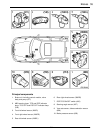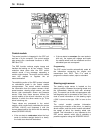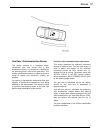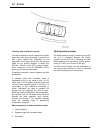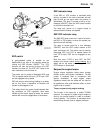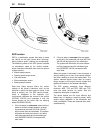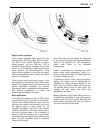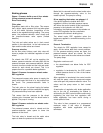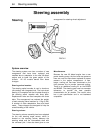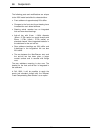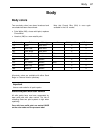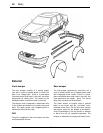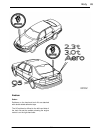
Brakes 63
9-5
Braking phases
Phase 1. Pressure build up on all four wheels
(filling pulse and pressure retention)
Driver not braking
Filler pulse
Regulation starts with a filler pulse. This means
that a slight, equal pressure build up takes place
in all the wheel cylinders, irrespective of the
wheel to be regulated during braking. The pump
starts, the pressure-reduction valve closes and
the pressure-increase valve opens (limited
duration).
The inlet and outlet valves are in their normal
position in the valve block, i.e. the inlet valves are
open and the outlet valves are closed.
Pressure retention
As the filler pulse finishes, each inlet valve will
close to prepare for individual regulation of each
wheel.
On wheels that ESP will not be applying the
brakes, pressure retention will take place as the
pressure-increase and pressure-reduction valves
on each circuit are closed and the inlet and outlet
valves for each wheel are closed. This is to
prepare them for a possible brake application.
Phase 2. Pressure increase on wheels under
ESP regulation
The pressure-increase valve opens to supply the
pump with brake fluid that is to be pumped into
the circuit. The pressure-reduction valve is
closed.
The inlet valve on the wheel having its brakes
applied will be open until the conditions that apply
for pressure build up have been attained.
This means that the pressure to the wheel
cylinders also increases and the wheel brake is
applied. The pump is running.
Phase 3. Pressure reduction on wheels under
ESP regulation
The pressure-increase valve is closed and the
pressure-reduction valve opens to lower the
pressure in the circuit.
The inlet valve is closed and the outlet valve
opens to lower the pressure at the wheels.
Brake fluid is returned from the wheel outlet valve
through the pressure-reducing valve to the
master cylinder. The pump is running.
Driver applying the brakes, see phases 1-3
If the driver applies the brakes while ESP
regulation is active, the brake pressure sensor
will inform the control module of the input brake
pressure in the hydraulic unit. With this
information, the brake pressure to the wheels not
under ESP regulation can be controlled to
correspond to the driver's braking force.
The wheel under ESP regulation when the
brakes are applied is controlled according to the
ESP criteria.
Phase 4. Termination
The criteria for ESP regulation have ceased to
apply. All the valves take their normal positions,
i.e. the pressure-reducing valves are open, the
pressure-increase valves are closed, the inlet
valves are open and the outlet valves are closed.
The pump stops.
Regulation continues until:
• the wheel/wheels are below limits for ESP
regulation.
• regulation is terminated by the ESP control
module because there is a risk of the brakes
overheating.
After regulation is terminated, the control module
will stop the pump, close the pressure-increase
valve and open the pressure-reduction valve. The
valves and the pump return to their normal
states.
A termination of regulation with brake application
due to the risk of overheating the brakes is
achieved by the ESP control module continuously
registering the total time that regulation with
brake application has been active during a
certain period of time.
This value is then compared to a programmed
maximum value. If this value is exceeded,
regulation with brake application will be
terminated.



